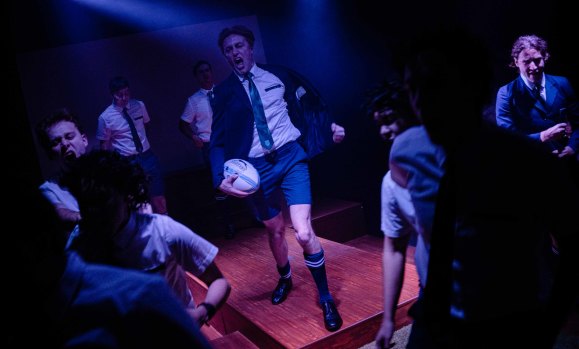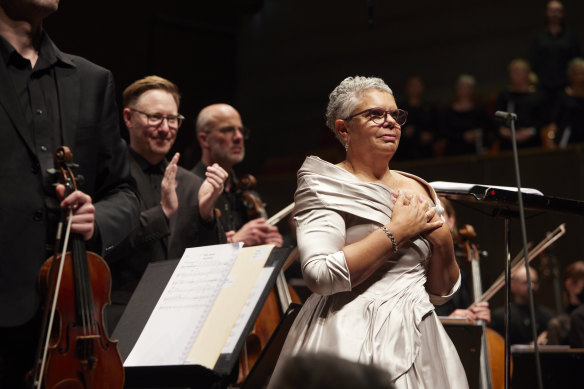
Backer is wondrously chameleonic as he flits (with barely a costume change) between his half-dozen characters, his body metamorphosing with each new voice, most notably the initially angelic Lilibet, whom he depicts across 55 years of her life. But the flitting is mostly between surfaces, as Tait gives Backer little psychological depth.
Jackman directs the production with technical assurance, having hit upon a delightful scenic vocabulary with designer Michael Hankin that involves minimal, slightly surreal furniture, dolls’ houses, and even a model train.
Much more than merely accomplished, Tait’s storytelling can be invigorating in its propulsive use of narration, and its bursts of lyricism, but the play remains a light comedy when something deeper is beckoning. The jangling confluence of bitterness, disloyalty and disappointment that mires us at the end could have entrapped us across more of the work – although those who find the royals innately fascinating may be more consistently engaged.
ALL BOYS
KXT on Broadway, September 11
Reviewed by Cassie Tongue
★★★★
Private all-boys schools – wealthy sites of elitism and entitlement that make future prime ministers and chief executives, haunted by whispers of violence and abuse – are, for better or worse, part of Sydney’s DNA.
All Boys, the play by Xavier Hazard making its Sydney premiere after appearing on the Griffin Award longlist (and a season at Perth’s Blue Room Theatre), feels like it’s landed exactly where it belongs. It tucks neatly and naturally into the tiny but ambitious KXT on Broadway, and as its cast of young men navigate the institutional perks, trials and toxicity of a top-tier, high-fee school, their voices echo so many just outside the theatre doors.

Robert Miniter (centre) as Josh in All Boys.Credit: Nicholas Warrand
Hazard’s deeply observational, gently moving and genuinely witty script builds on short, sharp scenes that drive its characters from year 7 through to graduation. There are boarders from country towns learning new rules, wealthy legacy students, and those on financial scholarships – and threats of assault, degradation and abuse.
The cast – all fresh from NIDA, many making stage debuts – is strong, instinctive and skilled (expect to see them on stage and screen again very soon). We watch the years roll by as the boys stare down their differences, desires, and ambitions – and grapple with the social cost of their choices.
Directed by Mehhma Malhi with clarity and care, the production is human-first, teasing out initial character sketches into thoughtful, three-dimensional studies that mostly resist shortcuts and stereotypes. Malhi shapes scenes, no matter how quick, to become the centre of the world (capturing that adolescent all-or-nothing drive).
She and her all-female creative team work in harmony with Hazard’s script to show how a society that wields masculinity as a weapon makes victims of boys as much as it does anyone who isn’t male. They do this by lingering on the damage – fraught silences, a crestfallen response, a defensive shrug.
While the play sits awkwardly at a two-hour runtime, introduces a hint of challenge to the system that comes too late and lands too softly, and a few emotional beats resolve without the rest of the play’s trademark nuance, the heart of All Boys is strong and sturdy. With a little reworking or restructuring to establish a smoother sense of escalation and emotional payoff, it could have a long life.
But even now, it’s an exciting glimpse, from playwright to creative team to cast, of new artists making their mark.
EUMERALLA, A WAR REQUIEM FOR PEACE
Sydney Symphony Orchestra
Opera House Concert Hall, September 11
Reviewed by Peter McCallum
★★★½
Eumeralla, A War Requiem for Peace by Deborah Cheetham Fraillon laments a war that many Australians haven’t heard of and seeks a peace most yearn for. The Eumeralla Wars were waged between the Gunditjmara people and colonial settlers from the 1830s to the 1860s in what is now south-west Victoria.
A Yorta Yorta woman, Cheetham Fraillon, along with linguists Vicki Couzens and Kris Eira, have created a text sung in the Gunditjmara language. This takes the Latin Requiem text, as known through canonical musical settings by Mozart, Verdi, Faure, and Britten, as a framework but expands its images and metaphors to incorporate Aboriginal spirituality.

Conductor Benjamin Northey applauds composer and soloist Deborah Cheetham Fraillon at a 2023 performance in Melbourne.Credit: Laura Manariti
Blending soloists (soprano Cheetham Fraillon, mezzo-soprano Linda Barcan and baritone Jud Arthur), the Dhungala Children’s Choir, students of the Conservatorium High School, Sydney Philharmonia Choirs and the Sydney Symphony Orchestra conducted by Benjamin Northey, the work unfolds over 19 short movements. Some are gnomic and end abruptly; others, such as Sanctus and Benedictus, join together in longer spans.
As each movement was performed, striking artworks by Gunditjmara artist Tom Day were projected, representing the landscape on which he grew up and the stories of his people’s defiance and resilience. Day’s images provided the key to matching the requiem form to Gunditjmara culture and history.
The text and image for the first movement, Requiem, described Pernmeyyal the “great creator”, while the music introduced quiet clarinet and soprano solos with the choir in a mournful mood and minor key.
Dies Irae was darker and more agitated, and that mood was developed menacingly up until the fifth movement, Agnus Dei. Here, the mode changed to major, and soprano, baritone, and choir mixed austere textures with short, woven imitative passages. There was also a short fugal episode in Domine Jesu Christe (xiii), but in general, Cheetham Fraillon’s style is defined by melody around sustained chords and clear tonality, avoiding extensive chromaticism or development.
Motives often exploit the sixth and fifth scale degrees, plaintively in minor keys and serenely in major. Ideas tend to be stated and move on, and in some places, the expressive tone subverts traditional expectations. Thus, Libera Me was laced with anguish and stern fateful motives, while Rex Tremendae began with a quiet instrumental introduction and peacefully extolled “the earth in all its beauty”. Ricordare (“remember”) began with quiet flute solo and soprano and ended in decisive firmness bordering on anger.
Although the dominant tone was of mournful sorrow, there were also more dramatic movements, such as the tempestuous Confutatis (xi), and the clamorous Hostias (xiv) which praised Pernmeyyal awaiting the homecoming of spirits. Some of the most effective instrumental and vocal writing was in Lux Aeternum (xvii), where the sectional nature of some movements gave way to more flowing and sweeping lines.
The penultimate Kyrie was rhythmically propelled and expansive. Cheetham Fraillon sang an acknowledgement of Country, Long Time Living Here, with soaring sound and had a major role in the Requiem. Linda Barcan articulated beautiful transparency and Jud Arthur with firm-edged incisiveness.
Conductor Benjamin Northey balanced the expansive forces on stage, at the back and in the east and west galleries with sensitivity and reverence, and the standing ovation at the end glowed with sincere warmth.



























